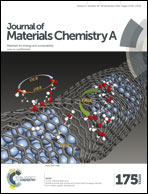Elucidating the charge carrier transport and extraction in planar heterojunction perovskite solar cells by Kelvin probe force microscopy†
Abstract
Perovskite solar cells have attracted much attention due to their high power conversion efficiency and low fabrication cost. The efficiency of the devices depends on the charge transport and charge extraction at the interface between the perovskite and electron or hole transport material. In this study, we use Kelvin probe force microscopy (KPFM) to investigate the charge carrier generation, transport, and extraction mechanism of several different structures with/without the hole/electron interlayers. It was found that the perovskite films exhibited unbalanced charge-carrier transport and extraction in the p-i-n type structure. Meanwhile, the leakage current under bias conditions can be suppressed by using a [6,6]-phenyl-C61-butyric acid methyl ester (PCBM) capping layer. The time-resolved photoluminescence (TR-PL) results reveal that the electrons have a longer lifetime and longer diffusion length than the holes in the perovskite layer. These results suggest that the electron extraction is more efficient than the hole extraction in the planar heterojunction devices of poly(3,4-ethylenedioxythiophene):polystyrene sulfonate (PEDOT:PSS)/perovskite/PCBM. These findings are beneficial for further optimizing the perovskite solar cells.



 Please wait while we load your content...
Please wait while we load your content...